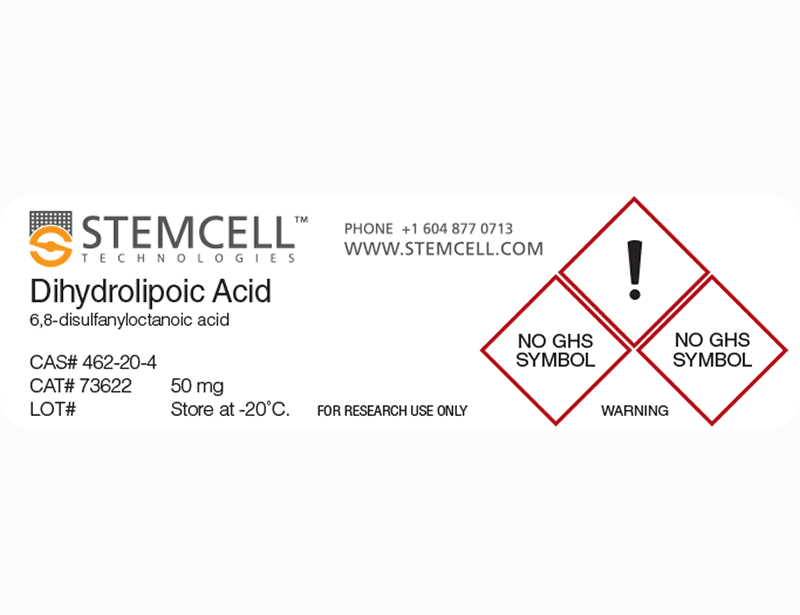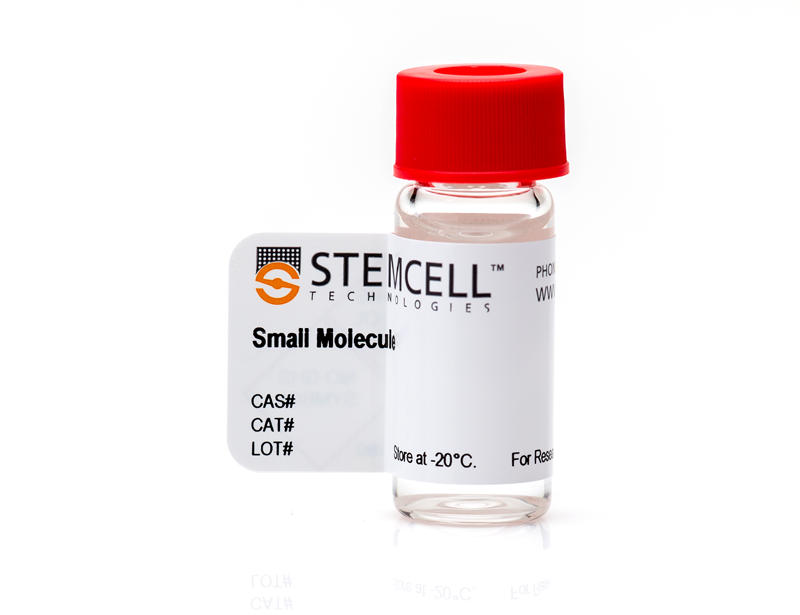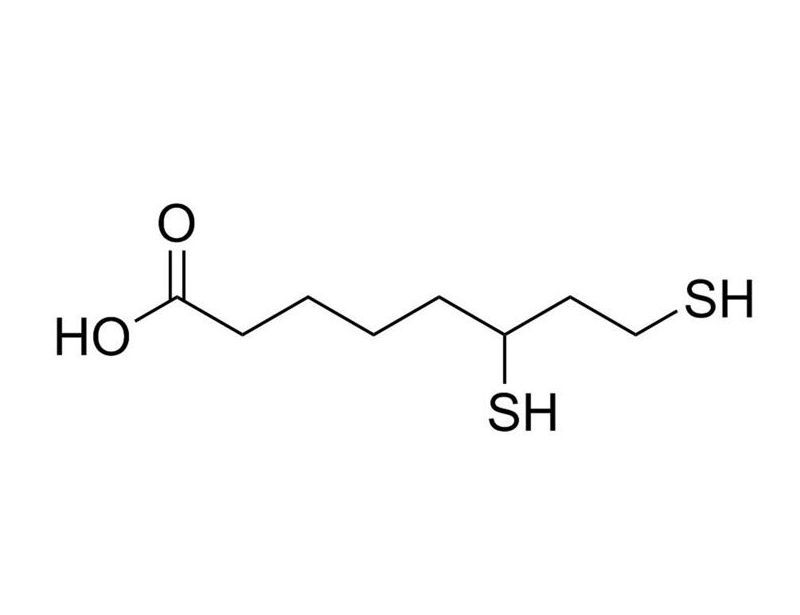Dihydrolipoic Acid
Antioxidant; Reducing agent
概要
Dihydrolipoic Acid (DHLA) is the reduced form of alpha-lipoic acid, and is a carboxylic acid containing two thiol groups (Moini et al.). It acts as a general antioxidant that is highly reactive against a variety of reactive oxygen species (ROS), including hydroxyl radicals, peroxynitrite, hydrogen peroxide, and hypochlorite, at concentrations ranging from 0.01 - 0.5 mM (Moini et al.). Dihydrolipoic acid has also been shown to recycle ubiquinone to the antioxidant active divalently reduced form (Nohl & Gille). Conversely, at concentrations higher than 50 - 100 μM, Dihydrolipoic acid directly increases the ROS content, along with a significant increase in cytoplasmic free calcium and nitric oxide (NO) levels, loss of mitochondrial membrane potential, activation of caspases-9 and -3, and cell death (Chan et al.; Houng et al.).
MAINTENANCE & SELF-RENEWAL
· Induces apoptosis and suppresses proliferation in mouse embryonic stem cells (ESC-B5) at a concentration range of 50 - 100 μM and consequently causes cell death at higher concentrations (Chan et al.; Houng et al.).
METABOLISM
· Reduces cytochrome b561, thereby decreasing ascorbate recycling and iron absorption (Bérczi et al.).
MAINTENANCE & SELF-RENEWAL
· Induces apoptosis and suppresses proliferation in mouse embryonic stem cells (ESC-B5) at a concentration range of 50 - 100 μM and consequently causes cell death at higher concentrations (Chan et al.; Houng et al.).
METABOLISM
· Reduces cytochrome b561, thereby decreasing ascorbate recycling and iron absorption (Bérczi et al.).
Alternative Names
Not applicable
Cell Type
Pluripotent Stem Cells
Species
Human, Mouse, Rat, Non-Human Primate, Other
Application
Maintenance
Area of Interest
Metabolism
CAS Number
462-20-4
Chemical Formula
C₈H₁₆O₂S₂
Molecular Weight
208.3 g/mol
Purity
≥ 95%
Target
ROS
技术资料
| Document Type | 产品名称 | Catalog # | Lot # | 语言 |
|---|---|---|---|---|
| Product Information Sheet | Dihydrolipoic Acid | 73622 | All | English |
| Safety Data Sheet | Dihydrolipoic Acid | 73622 | All | English |
数据及文献
Publications (5)
European biophysics journal : EBJ 2013 MAR
Dihydrolipoic acid reduces cytochrome b561 proteins.
Abstract
Abstract
Cytochrome b561 (Cyt-b561) proteins constitute a family of trans-membrane proteins that are present in a wide variety of organisms. Two of their characteristic properties are the reducibility by ascorbate (ASC) and the presence of two distinct b-type hemes localized on two opposite sides of the membrane. Here we show that the tonoplast-localized and the putative tumor suppressor Cyt-b561 proteins can be reduced by other reductants than ASC and dithionite. A detailed spectral analysis of the ASC-dependent and dihydrolipoic acid (DHLA)-dependent reduction of these two Cyt-b561 proteins is also presented. Our results are discussed in relation to the known antioxidant capability of DHLA as well as its role in the regeneration of other antioxidant compounds of cells. These results allow us to speculate on new biological functions for the trans-membrane Cyt-b561 proteins.
Environmental toxicology 2013 FEB
Impact of dihydrolipoic acid on mouse embryonic stem cells and related regulatory mechanisms.
Abstract
Abstract
α-Lipoic acid (LA) is a thiol with antioxidant properties that protects against oxidative stress-induced apoptosis. LA is absorbed from the diet, taken up by cells and tissues, and subsequently reduced to dihydrolipoic acid (DHLA). Recently, DHLA has been used as the hydrophilic nanomaterial preparations, and therefore, determination of its bio-safety profile is essential. In this article, we show that DHLA (50-100 μM) induces apoptotic processes in mouse embryonic stem cells (ESC-B5), but exerts no injury effects at treatment dosages below 50 μM. Higher concentrations of DHLA (50-100 μM) directly increased the reactive oxygen species (ROS) content in ESC-B5 cells, along with a significant increase in cytoplasmic free calcium and nitric oxide (NO) levels, loss of mitochondrial membrane potential (MMP), activation of caspases-9 and -3, and cell death. Pretreatment with NO scavengers suppressed the apoptotic biochemical changes induced by 100 μM DHLA and promoted the gene expression levels of p53 and p21 involved in apoptotic signaling. Our results collectively indicate that DHLA at concentrations of 50-100 μM triggers apoptosis of ESC-B5 cells, which involves both ROS and NO. Importantly, at doses of less than 50 μM (0-25 μM), DHLA does not exert hazardous effects on ESC-B5 cell properties, including viability, development and differentiation. These results provide important information in terms of dosage safety and biocompatibility of DHLA to facilitate its further use as a precursor for biomaterial preparation.
International journal of molecular sciences 2012 JAN
Dihydrolipoic acid induces cytotoxicity in mouse blastocysts through apoptosis processes.
Abstract
Abstract
α-Lipoic acid (LA) is a thiol with antioxidant properties that protects against oxidative stress-induced apoptosis. LA is absorbed from the diet, taken up by cells and tissues, and subsequently reduced to dihydrolipoic acid (DHLA). In view of the recent application of DHLA as a hydrophilic nanomaterial preparation, determination of its biosafety profile is essential. In the current study, we examined the cytotoxic effects of DHLA on mouse embryos at the blastocyst stage, subsequent embryonic attachment and outgrowth in vitro, in vivo implantation by embryo transfer, and early embryonic development in an animal model. Blastocysts treated with 50 μM DHLA exhibited significantly increased apoptosis and a corresponding decrease in total cell number. Notably, the implantation success rates of blastocysts pretreated with DHLA were lower than that of their control counterparts. Moreover, in vitro treatment with 50 μM DHLA was associated with increased resorption of post-implantation embryos and decreased fetal weight. Data obtained using an in vivo mouse model further disclosed that consumption of drinking water containing 100 μM DHLA led to decreased early embryo development, specifically, inhibition of development to the blastocyst stage. However, it appears that concentrations of DHLA lower than 50 μM do not exert a hazardous effect on embryonic development. Our results collectively indicate that in vitro and in vivo exposure to concentrations of DHLA higher than 50 μM DHLA induces apoptosis and retards early pre- and post-implantation development, and support the potential of DHLA to induce embryonic cytotoxicity.
Toxicology and applied pharmacology 2002 JUL
Antioxidant and prooxidant activities of alpha-lipoic acid and dihydrolipoic acid.
Abstract
Abstract
Reactive oxygen (ROS) and nitrogen oxide (RNOS) species are produced as by-products of oxidative metabolism. A major function for ROS and RNOS is immunological host defense. Recent evidence indicate that ROS and RNOS may also function as signaling molecules. However, high levels of ROS and RNOS have been considered to potentially damage cellular macromolecules and have been implicated in the pathogenesis and progression of various chronic diseases. alpha-Lipoic acid and dihydrolipoic acid exhibit direct free radical scavenging properties and as a redox couple, with a low redox potential of -0.32 V, is a strong reductant. Several studies provided evidence that alpha-lipoic acid supplementation decreases oxidative stress and restores reduced levels of other antioxidants in vivo. However, there is also evidence indicating that alpha-lipoic acid and dihydrolipoic acid may exert prooxidant properties in vitro. alpha-Lipoic acid and dihydrolipoic acid were shown to promote the mitochondrial permeability transition in permeabilized hepatocytes and isolated rat liver mitochondria. Dihydrolipoic acid also stimulated superoxide anion production in rat liver mitochondria and submitochondrial particles. alpha-Lipoic acid was recently shown to stimulate glucose uptake into 3T3-L1 adipocytes by increasing intracellular oxidant levels and/or facilitating insulin receptor autophosphorylation presumably by oxidation of critical thiol groups present in the insulin receptor beta-subunit. Whether alpha-lipoic acid and/or dihydrolipoic acid-induced oxidative protein modifications contribute to their versatile effects observed in vivo warrants further investigation.
Zeitschrift für Naturforschung. C, Journal of biosciences 1998 JAN
Evaluation of the antioxidant capacity of ubiquinol and dihydrolipoic acid.
Abstract
Abstract
Ubiquinone and alpha-lipoic acid are natural constituents which are involved in mitochondrial energy metabolism. Their bioenergetic activities require redox-cycling. In the case of alpha-lipoic acid redox-cycling leads to dihydrolipoic acid which occurs in multienzyme complexes involved in the citric acid cycle while UQ recycles through semi- and divalently reduced ubiquinones in the respiratory chain. We have proved the validity of the concept about the antioxidant function of these natural compounds in their reduced form. Ubiquinol was found to interfere with lipid peroxidation of liposomal membranes being itself degradated by two consecutive oxidation steps. Dihydrolipoic acid was found to totally recycle ubiquinone to the antioxidant active divalently reduced form. In contrast to the antioxidative derived reaction products of ubiquinols which in turn promoted lipid peroxidation, the antioxidant derived reaction product of dihydrolipoic acid was the unreactive two electron oxidation product alpha-lipoic acid. Our experiments demonstrate the existence of an dihydrolipoic acid driven recycling of UQ to the antioxidative-active UQH2. The efficiency of the antioxidative capacity of the latter was found to be diminished through prooxidant activities of the antioxidant-derived metabolites.



